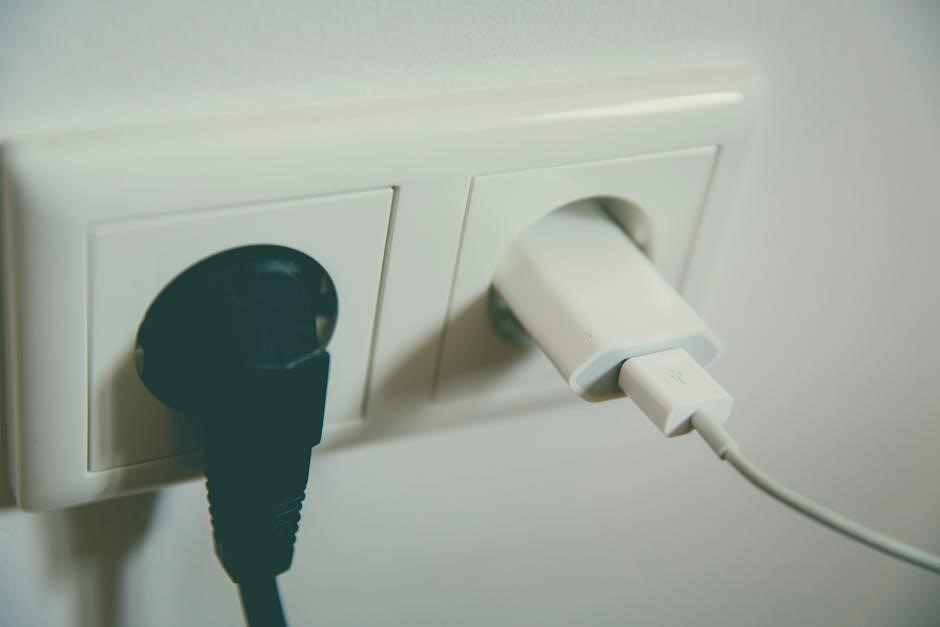Welcome to the Black and Decker Charger Manual. This guide provides essential information for safe‚ effective‚ and optimal use of your charger. Explore features‚ safety tips‚ and troubleshooting solutions.
1.1 Overview of the Black and Decker Charger
The Black and Decker Charger is a versatile device designed for charging various battery types‚ ensuring optimal performance for your tools. Popular models like the LDX120C and BM3B offer 6V/12V charging capabilities‚ featuring multiple voltage settings and LED indicators for easy monitoring. These chargers are compatible with a range of Black and Decker tools and batteries‚ including Li-Ion packs. Safety features emphasize proper usage and storage‚ with guidelines to avoid hazards and ensure environmental responsibility.
1.2 Importance of Reading the Manual
Reading the Black and Decker Charger Manual is crucial for understanding safety guidelines‚ proper usage‚ and troubleshooting. It ensures you use the charger correctly‚ avoiding risks like electrical hazards or battery damage. The manual provides detailed instructions for charging various battery types‚ including Li-Ion and lead-acid batteries. It also covers environmental compliance and maintenance tips. By following the manual‚ you can optimize performance‚ extend battery life‚ and ensure safe operation. Refer to it for specific model instructions and customer support resources to address any concerns effectively.

Safety Precautions
Ensure safety by reading the manual thoroughly; Avoid electrical hazards‚ keep flames away‚ and dispose of batteries properly. Use only specified chargers for optimal performance.
2.1 Electrical Safety Guidelines
Always use the charger indoors and avoid exposure to water or moisture. Ensure the charger is double-insulated and avoid naked flames nearby. Use only the specified chargers for your Black and Decker tools. Keep the charging area clean and well-ventilated. Never overload outlets or use damaged cords. Regularly inspect the charger for signs of wear. Properly dispose of batteries to prevent environmental harm. Follow all electrical safety standards to ensure safe and efficient charging.
2.2 Proper Usage and Handling
Plug the charger into a suitable outlet before connecting the battery. Ensure the battery is properly seated in the charger. Avoid overcharging‚ as this can damage the battery. Always connect the positive (red) clamp to the positive terminal and the negative (black) clamp to the negative terminal. Keep the charger away from flammable materials and never leave it unattended while in use. Proper handling ensures efficient charging and prolongs the lifespan of both the charger and the battery.
2.3 Emergency Procedures
In case of an emergency‚ immediately disconnect the charger from the power source and the battery. If there’s smoke or overheating‚ keep the area well-ventilated but avoid inhaling fumes. Do not use water to extinguish electrical fires. Wear protective gloves and eyewear. If a battery ruptures‚ avoid direct contact with leaking fluids. For severe malfunctions‚ contact Black and Decker customer support or an authorized service center. Always follow manufacturer guidelines to ensure safety and prevent further damage.

Understanding the Charger Components
Familiarize yourself with the charger’s key components‚ including the charging port‚ LED indicators‚ and power cord. These elements ensure safe and efficient battery charging for optimal performance.
3.1 Identification of Charger Parts
Identify the key components of your Black and Decker charger‚ such as the charging port‚ LED indicators‚ and power cord. The charging port connects to the battery‚ while LED lights indicate charging status. The power cord ensures a stable electrical connection. Additionally‚ some models feature clamps for direct battery terminal charging. Familiarizing yourself with these parts is essential for proper usage and troubleshooting. Always refer to the manual for specific component locations and functions.
3.2 Types of Black and Decker Chargers
Black and Decker offers a variety of chargers designed for specific needs. Models like the LDX120C and BM3B cater to vehicle batteries‚ while the BDV1084 and BDV066 are tailored for power tools. Some chargers‚ such as the BDC2A‚ support 18V and 54V Li-Ion batteries‚ offering dual-volt technology for versatility. High-frequency smart chargers provide efficient charging‚ while others feature clamps for direct terminal connections. Each type ensures compatibility with corresponding Black and Decker tools‚ making them suitable for different applications and user preferences.
3.3 Charging Indicators and Lights
Black and Decker chargers feature indicator lights to monitor charging status. A red light often signifies a bad connection or reverse polarity‚ while a green light indicates successful charging. Some models include a yellow light for maintenance mode or issue detection. These indicators help users troubleshoot common problems‚ such as overcharging or overheating. Always refer to the manual for specific light meanings‚ as they may vary by model. Properly interpreting these signals ensures safe and efficient battery charging and maintenance.

Charging Procedures
Black and Decker chargers are designed for safe and efficient battery charging. Always plug in the charger first‚ then connect the battery‚ and monitor the process to ensure proper charging and safety.
4.1 Preparing to Charge
Before charging‚ ensure the battery is compatible with your Black and Decker charger. Remove any protective coverings and verify the terminals are clean. Properly seat the battery in the charger‚ aligning the terminals correctly. Plug the charger into a nearby outlet and check for any damage to the cord or connectors. Ensure the charging area is well-ventilated and away from flammable materials. Refer to the manual for specific voltage settings and safety guidelines to avoid any potential hazards during the charging process. Always follow the manufacturer’s instructions for optimal performance and safety.
4.2 Step-by-Step Charging Instructions
Plug the charger into a nearby electrical outlet. Ensure the outlet matches the charger’s voltage requirements. 2. Insert the battery into the charger‚ aligning the terminals correctly. 3. Select the appropriate voltage setting if your charger has multiple options. 4. Turn on the charger and monitor the charging indicators. 5. Allow the battery to charge until the indicator shows completion; 6. Unplug the charger and let the battery cool before use. Always follow the manufacturer’s guidelines to ensure safety and efficiency.
4.3 Post-Charging Care and Storage
After charging‚ unplug the charger and allow the battery to cool. Store the battery in a dry‚ cool place away from direct sunlight. Avoid extreme temperatures. Clean the charger and battery terminals regularly to ensure proper conductivity. For long-term storage‚ charge the battery to 50% capacity and store it in a protective case. Recharge every 3-6 months to maintain health. Proper care extends the lifespan and efficiency of your Black and Decker charger and battery.

Troubleshooting Common Issues
Identify and resolve common charger issues‚ such as no power‚ slow charging‚ or error lights. Check connections‚ ensure proper battery seating‚ and avoid overcharging. Consult the manual for solutions.
5.1 Common Charging Problems
Common issues include the charger not turning on‚ slow charging‚ or error lights. Check for loose connections‚ damaged cables‚ or incorrect voltage settings. Ensure the battery is properly seated and compatible with the charger. If the charger malfunctions‚ unplug it‚ wait‚ and restart. For persistent issues‚ refer to the troubleshooting section or contact Black and Decker support. Always follow safety guidelines to avoid further complications during the charging process.
5.2 Diagnosing Charger Malfunctions
To diagnose charger issues‚ start by checking the power source and connections. Ensure the charger is properly plugged in and the outlet is functional. Inspect the cord and plugs for damage. If the charger has error lights‚ refer to the manual for their meaning. Check for loose or corroded battery terminals and clean them if necessary. Verify that the battery is compatible with the charger. For advanced issues‚ use a multimeter to test voltage output. If problems persist‚ contact Black and Decker support for assistance.
5.3 Resetting the Charger
To reset the charger‚ unplug it from the power source and disconnect it from the battery. Wait for 30 seconds to allow any residual power to discharge. Plug the charger back in and ensure it is properly connected to both the power outlet and the battery. Check the error lights or indicators to confirm the reset was successful. If issues persist‚ consult the user manual for specific reset procedures or contact Black and Decker customer support for further assistance.

Maintenance and Care
Regularly clean the charger and store it in a dry‚ cool place. Check for wear and tear‚ and replace damaged parts promptly to ensure optimal performance and safety.
6.1 Cleaning the Charger
Regular cleaning ensures your charger operates efficiently. Use a soft‚ dry cloth to wipe the exterior‚ removing dust and debris. Avoid using liquids or harsh chemicals‚ as they may damage the unit. For tougher stains‚ lightly dampen the cloth with water‚ but ensure the charger is unplugged. Never submerge the charger in water. Check the charging ports for debris and clean gently with compressed air if needed. Proper cleaning maintains performance and safety‚ preventing overheating and ensuring reliable charging. Always refer to the manual for specific cleaning guidelines.
6.2 Storing the Charger Properly
Store the charger in a cool‚ dry place‚ away from direct sunlight and moisture. Avoid leaving it in vehicles or humid environments. Keep it out of reach of children and flammable materials. When not in use‚ disconnect the charger from both the power source and the battery. Store it in its original packaging or a protective case to prevent damage. Periodically inspect the charger for signs of wear or damage. Proper storage extends the charger’s lifespan and ensures safe‚ reliable performance. Always follow the manufacturer’s storage guidelines for optimal results.
6.3 Replacing Damaged Parts
If your charger has damaged parts‚ replace them promptly to ensure safe and efficient operation. Visit the official Black & Decker website or authorized service centers for genuine replacement parts. Use only manufacturer-approved components to maintain warranty validity. For assistance‚ contact Black & Decker support or refer to the ServiceNet portal for repair options. Proper replacement ensures optimal performance and prevents potential hazards. Always follow the instructions provided with replacement parts for a secure and correct installation;

Compatibility with Black and Decker Tools
Ensure your charger is compatible with Black and Decker tools by checking the manual or manufacturer’s website. Use only recommended chargers for safe and optimal performance.
7.1 Compatible Battery Types
Black and Decker chargers are designed to work seamlessly with specific battery types‚ ensuring optimal performance and safety. Compatible batteries include 18V Li-Ion and 54V DUALVOLT packs. Always use recommended batteries to avoid damage and ensure proper charging. The charger is tailored for Black and Decker tools‚ providing consistent power delivery. Refer to the manual or manufacturer’s website for a full list of compatible batteries and voltage requirements. Using the correct battery type ensures efficient charging and extends tool lifespan.
- 18V Lithium-Ion (Li-Ion) batteries
- 54V DUALVOLT Li-Ion batteries
- Lead-acid batteries (for select models)
Using incompatible batteries can lead to safety risks or poor performance. Always follow the manufacturer’s guidelines for battery compatibility.
7.2 Voltage and Power Specifications
Black and Decker chargers are designed to support various voltage and power requirements. Most models accommodate 18V and 54V battery systems‚ ensuring compatibility with a wide range of tools. The DualVolt technology allows seamless switching between voltage levels. Chargers typically deliver 2-8 amps‚ depending on the model and battery type. Always refer to the manual for specific voltage and power ratings to ensure safe and efficient charging. Using the correct charger for your tool’s voltage prevents damage and prolongs battery life.
7.3 Using Third-Party Batteries
Using third-party batteries with your Black and Decker charger may lead to compatibility issues or damage. Ensure any third-party batteries meet the voltage and power specifications outlined in your charger’s manual. Improper use can void your warranty or cause safety hazards. Always prioritize Black and Decker-approved batteries for optimal performance and safety. If unsure‚ consult the manual or contact customer support for verification before using non-authorized products.

Accessing the Full Manual
Access the full Black and Decker charger manual by downloading it from their official website or visiting authorized service centers. Print it for easy reference and detailed instructions always.
8.1 Downloading the PDF Manual
To download the Black and Decker charger manual‚ visit the official website and navigate to the support section. Select your product model‚ choose the manual‚ and click the download button. Ensure the PDF is saved for future reference. This manual provides detailed instructions‚ safety guidelines‚ and troubleshooting tips. Always use the latest version for accurate information. Accessing the PDF ensures you have all the necessary information at your fingertips for optimal charger use and maintenance.
8.2 Printing the Manual
To print the Black and Decker charger manual‚ first download the PDF version from the official website; Open the file using a PDF reader‚ then select the print option. Ensure your printer settings match the document size and orientation. Print all pages or specific sections as needed. Consider using double-sided printing to save paper. Having a printed copy provides easy access to instructions without needing a device. Store it near your charger for quick reference during use or troubleshooting.

Customer Support and Resources
Black and Decker offers comprehensive support through their website‚ FAQs‚ and authorized service centers. Contact their team for assistance or visit their official site for resources and updates.
9.1 Contacting Black and Decker Support
For assistance‚ visit the official Black and Decker website or contact their support team directly. Use the website’s chat feature‚ email‚ or phone options for help with your charger. The website also offers a community section where you can engage with other users and find answers to common questions. Additionally‚ FAQs and troubleshooting guides are available online to address your concerns promptly and efficiently. Ensure to have your product details ready for faster support.
9.2 Finding Authorized Service Centers
To locate an authorized Black and Decker service center‚ visit their official website and use the service center locator tool. Enter your location to find nearby centers. Contact customer support for assistance or refer to the manual for more details. Ensure the center is officially recognized to guarantee authentic and reliable service for your charger and tools.
9.3 Frequently Asked Questions
For common inquiries about your Black and Decker charger‚ refer to the FAQs section. Topics include troubleshooting charging issues‚ battery compatibility‚ and maintenance tips. Learn how to resolve errors‚ optimize charging times‚ and extend the lifespan of your charger. Visit the official website or consult the manual for detailed answers to your questions and ensure optimal performance of your Black and Decker tools and chargers.

Environmental Considerations
Ensure proper disposal of batteries and recyclable materials. Follow guidelines for energy efficiency and eco-friendly practices to minimize environmental impact while using your charger.
10.1 Proper Disposal of Batteries
Properly dispose of batteries to prevent environmental harm. Check local regulations for recycling options. Do not dispose of batteries in regular trash. For large batteries‚ disconnect terminals and tape them to prevent short circuits. Recycle lead-acid batteries at authorized centers. Always follow eco-friendly practices to minimize environmental impact. Consult your local waste management for specific guidelines. Proper disposal ensures safety and sustainability.
10.2 Recycling Options
Black and Decker encourages eco-friendly practices by offering recycling options for batteries and chargers. Participate in authorized recycling programs to ensure responsible disposal. Many retailers and service centers accept used batteries for proper recycling. Visit the official Black and Decker website or contact local recycling facilities for details. Prepare batteries by discharging them fully and securing terminals to prevent short circuits. Recycling helps conserve resources and reduces environmental impact.
10.3 Energy Efficiency Tips
To maximize energy efficiency‚ use Black and Decker chargers with high-efficiency ratings. Avoid overcharging by monitoring charging times and using smart chargers with automatic shut-off. Store batteries in cool‚ dry places to maintain capacity. Unplug chargers when not in use to reduce standby power consumption. Regularly maintain chargers and batteries to ensure optimal performance. Consider upgrading to energy-efficient models for long-term savings and environmental benefits.
By following this manual‚ you’ll optimize your Black and Decker charger’s performance. Always adhere to safety guidelines and manufacturer recommendations for a seamless experience.
11.1 Final Tips for Optimal Charger Use
Always ensure proper connections and avoid overcharging. Store the charger in a cool‚ dry place. Regularly inspect cables for damage. Use only compatible batteries.
Keep the charging area well-ventilated. Follow the manual for specific battery types. Avoid unauthorized modifications. For optimal performance‚ clean the charger periodically.
Refer to the manual for troubleshooting complex issues. By adhering to these tips‚ you’ll extend the lifespan and efficiency of your Black and Decker charger.
11.2 Staying Updated with ManufacturerGuidelines
11.2 Staying Updated with Manufacturer Guidelines
Regularly visit the official Black and Decker website for updates and guidelines. Check for firmware updates or software downloads for your charger.
Register your product to receive notifications about new guidelines or recalls. Refer to FAQs and community forums for troubleshooting tips.
Always follow safety guidelines and best practices outlined by the manufacturer. Keep your charger clean and store it properly.
By staying informed‚ you ensure optimal performance and longevity of your Black and Decker charger.

